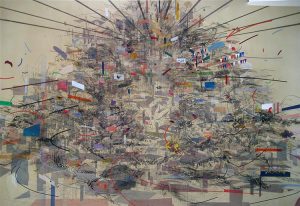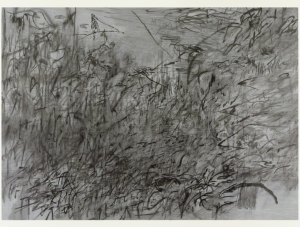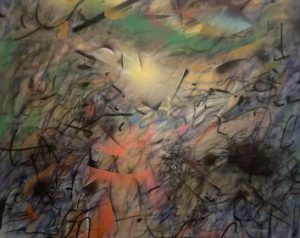Prachi Sahasrabudhe
Born in 1970, Julie Mehretu is an Ethiopian- American Visual artist working consistently in the contemporary art field for more than two decades. Her conscious

Courtesy- Wikipedia
practice in painting, drawing, printmaking, enforces the artistic expression to evoke recurring conflicts, injustice, and social unrest through the histories. Her paintings represent elements of mapping and architecture, overlapped to achieve calligraphic complexity that represents compressed social matrixes, holding multiple realms and vantage points.
Ethiopian by birth, Mehretu graduated with a BA from Kalamazoo College, Michigan (1992) and completed MFA from Rhode Island School of Design, Providence (1997). After the graduation she attended several residency programs for couple of years. Julie Mehretu’s abstract paintings have received international acclaim and recognition. Some of her major exhibitions and achievements involve Berlin Prize, Macarthur Foundation Award, Carnegie International, Sydney Biennale, Istanbul Biennial, and many more. Recently, Mehretu has been featured in ‘Time’s 100 Most Influential People of 2020’.
Since 1996, Mehretu has created many paintings and drawings playing with the parameters of abstraction, architecture, landscape, scale, and figuration. Mehretu’s art practice revolves around lived experiences, and examines how politics create world currents.
I think architecture reflects the machinations of politics, and that’s why I am interested in it as a metaphor for those institutions. I do not think of architectural language as just a metaphor about space, but about spaces of power, about ideas of power.
-Mehretu,2019
Escaping the political violence in Ethiopia, Mehretu’s parents moved to the USA during her childhood. Mehretu’s artistic practice is somewhere influenced from her experience of politicised migration and violence. Mehretu’s works revive art histories through geographical, social, and political perspectives. Her dynamic pictorials are conflation of images and storytelling sourcing from multiple concepts of politics, literature, music and broadcasted photographic images. The rapid lines and colliding forms in Mehretu’s painting depict historic episodes of social-geological-global unrest due to land invasions and their after effects engaging with colonialism, architecture, human habitats, and spaces.

Courtesy- Atelierlog
Mehretu’s work ‘Mogamma, Painting in Four Parts’ depicts a place that billowed in smoke. Rendering visual elements to create a porous effect of ember and ether, in this work, Mehretu, marks what was lost in the maelstrom of ash and debris at Tahrir Square, Cairo. The mapping in this work indicates movement, chaos, transient and altering nature of the place and crowd. The geometric marks and lines represent continuity while, cross hatching of latitude and longitude, the spiral twists, layers of spaces and architecture tells a story of a storm. The work reveals an aerial view of urban landscape, represented in fragments challenging their existing specificity. The painting uses layers of architectural drawings, geometric patterns, and pen and ink contours to represent light and space. They form a grid like mesh of lines indicating verticality of underlying images of facades and skylines. The wax like surface is developed over months to show light and depth, with delicate depictions of fire, explosions, and multi-dimensional perspectives. The elevations in the compositions assert a sense of direction in the whirlpool of patterns. The occasional placement of solid-coloured geometric forms such as ellipses, circles, triangles, quadrilaterals form a structure to keep everything intact. Radically flat yet immersive in impact, the massive four panels of this painting narrate the story of a place and people from above and within.
Mehretu’s image making process is a mix of photographic projections, blueprints, computerised graphic images and video-game technologies, building the fictional world onto prepared canvases, further traced by minimizing and modifying elements, in layer-by-layer application of acrylic paint. The results are assertively hybrid.

Mehretu’s painting ‘Empirical Construction, Istanbul’ is a painting and drawing hybrid representing the city of Istanbul, which has the historical significance of being capital of diverse empires. She renders ‘portrait of the city’ of Istanbul, with details layered within the thin sheets of acrylic sprayed onto the canvas. She articulates the texture of the city incorporating both modernised and native cultures in metaphoric approach by using symbols and signifiers like star, crescent, flags, Islamic architectural and decorative motifs. The painting evokes the city’s past, present, and future through delicate outlines and coloured planes, derived from self-documented panoramic photographs and blueprints of the modernisation. The angled and arching lines can be seen scattering away from the centre of the painting revealing ghostly skeleton of the cityscape. The painting was displayed in Istanbul Biennial in 2003.

Courtesy- Artsy
Mehretu is recognised for her big scale works that affords a room for bird’s eye view and axonometric slits. The paintings create interweaving surfaces consisting of clustered shapes, lines, and intersecting patterns. The sweeping scale of her history paintings creates an illusional energy that engages the viewer into the details, providing a window to view the pre existing and anticipate the forthcoming elements in the clustered trail of lines and forms, creating crowded maps of many twists and turns – just as the events in history.
The spectator is the focal point of Mehretu’s monumental paintings. The viewer’s perception is important as she makes sure to provide it with alluring challenge and curiosity through the arial views hung upon a wall. The enormous scale of her paintings succeeds in leaving an imprint on the viewer’s mind, allowing them to delve into the details of immersive, understated, violent and muted elements in the visuals.
Mehretu’s architectural sketches explore events across European history of civilisations to African liberation movements. The lines in Mehretu’s works represent movement and the passage of time, which in her words, “behave, battle, migrate and civilize.” Mehretu’s paintings reveal expression of our world, resonating with maps, weather systems, patterns, urban sprawl represented through fragments of architectural renderings, topographical symbols and multiple forms of mark making. Mehretu’s paintings develop their language from constructivism to futurism constituting contemporary questions about interlinking utopian impulses and abstraction. The titles and images in her works, occasionally hint at their representational origins, but the language of her artistic expression remains resolutely abstract.

Courtesy- Wikipedia
References
Online Sources:
- https://www.moma.org/artists/25414
- https://art21.org/artist/julie-mehretu/
- https://whitney.org/exhibitions/julie-mehretu
- https://www.studiointernational.com/julie-mehretu-cities-in-the-maelstrom-an-essay-mogamma
- https://www.youtube.com/watch?v=i6cawbOpqDE
- https://libraryguides.saic.edu/VAP/bradford_mehretu
Published Sources :
- “ Among Others: Blackness at MoMA” , ed. Darby English and Charlotte Barat (New York: The Museum of Modern Art, 2019)
- “MoMA Highlights: 375 Works from The Museum of Modern Art” , New York (New York: The Museum of Modern Art, 2019).





